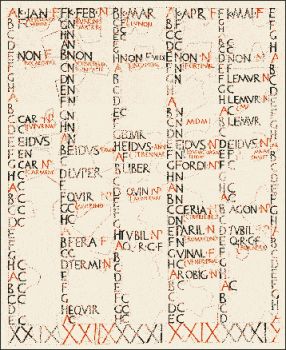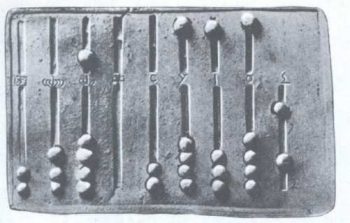The discovery of America in Latin Posted by leire on Feb 7, 2012
Here is a selection of short texts from the Latin translation of Columbus’ letter to Gabriel Sanchez, treasurer of the kingdom of Aragon, on March 14, 1493, giving news of his first voyage to the Indies. The Castilian text was soon translated into Latin by Leandro de Cosco for spreading rapidly the news of the…
XVIII International Botanical Congress and the end of the use of Latin Posted by leire on Jan 31, 2012
The title of this post is not completely faithful to reality. Recently, during the XVIII International Botanical Congress, it was decided that from January 1st 2012 it would not be compulsory to use Latin for botanical description of species. Now you can use either Latin or English. The names of the plants, though, will remain…
Roman calendar Posted by leire on Jan 29, 2012
The calendar we use nowadays corresponds with very light variations, to the one that Julius Caesar used. However, in the history of the Roman calendar we can distinguish three stages: initial, Numa Pompilius’ reform, and the reform of Julius Caesar. In the initial phase, which was a lunar calendar, the year was made up of…
Education in Ancient Rome Posted by leire on Jan 25, 2012
OLD PERIOD (until the second century BC): At this time in the history of Ancient Rome, the education of children was limited to the preparation that their father could give. It was an education of farmers, based fundamentally on respect for the customs of the ancestors (mos maiorum). From early childhood they were taught that…
The Latin Passive Voice Posted by leire on Jan 22, 2012
In Latin, as in other languages, the verb has two voices: active and passive. For crating the passive voice, Latin language uses two different systems: one for the present tense, and another for the perfect tense. PASSIVE VOICE IN PRESENT TENSE: To form the passive voice of present tense, both for the indicative and…
Latin Epigraphy III: abbreviations Posted by leire on Jan 14, 2012
PRAENOMINA: some of the most common names A. Aulus L. Lucius SEX. Sextus AP. Appius M. Marcus S. (SP.) Spurius C. Caius (Gaius) P. Publius T. Titus CN. Cnaeus (Gnaeus) Q. Quintus TI. Tiberius D. Decimus SER. Servius FILIATION: it is usually written between nomen and cognomen F. Filius, -a LIB. Libertus, -a CON…
Latin Epigraphy II Posted by leire on Jan 11, 2012
TYPES OF INSCRIPTIONS Honorary: in statues or monuments devoted to an important figure. Name of the figure (in dative, also in nominative or otherwise), name of the dedicator (nominative), dedication reasons and possible additional sentences. Funerary: in the tombs or other monuments erected in memory of a deceased. The formulas varied over time and places, but the…





